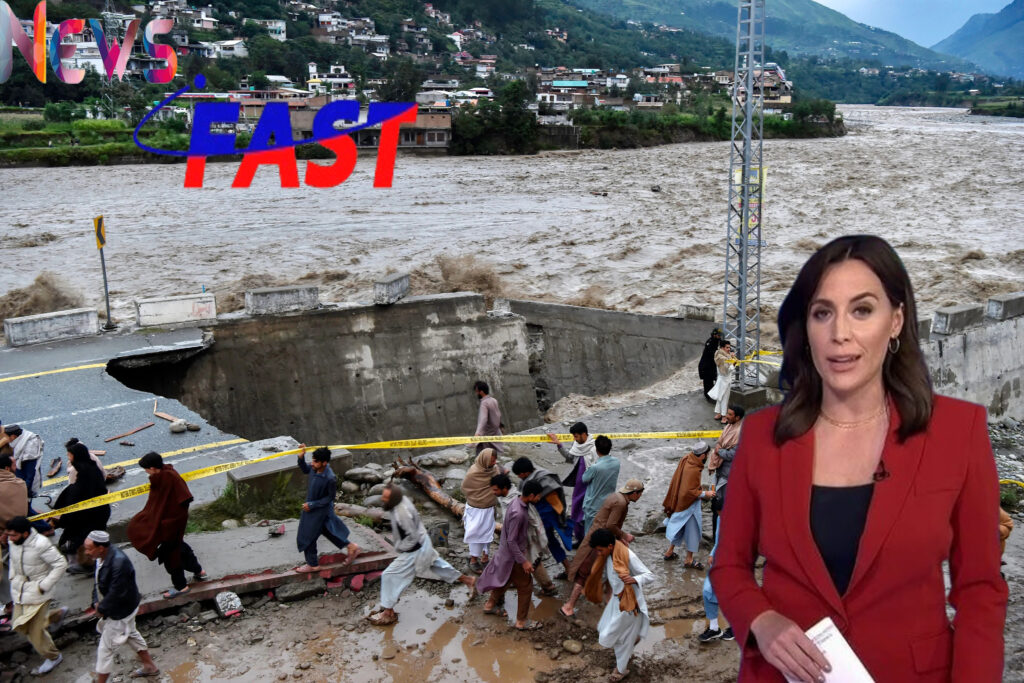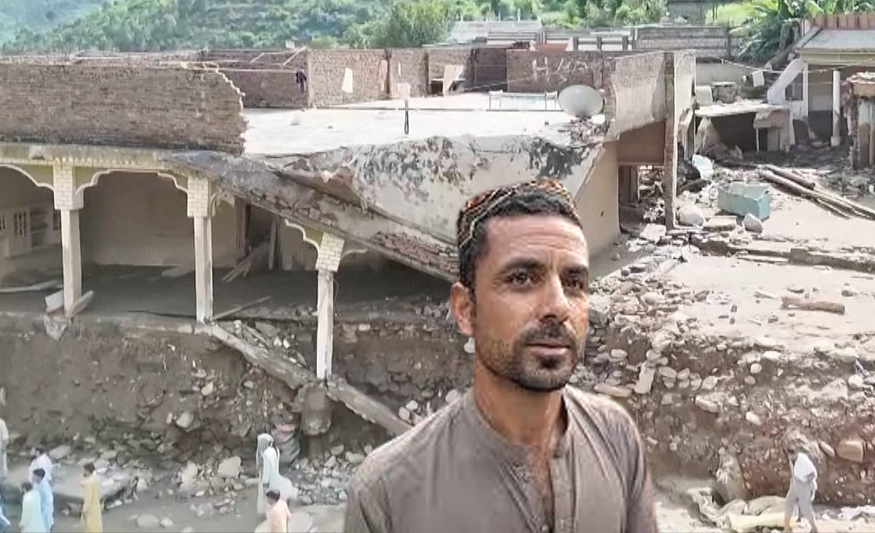Floods keep ravaging Pakistan – we are can it protect itself better 2025
In a remote village in Swabi district,
Khyber Pakhtunkhwa, sorrow and anger filled the air as locals recovered the bodies of two children, their clothes drenched in mud, following A sudden flash flood destroyed several homes, trapping dozens of people under the wreckage
Villagers stood silently, some watching the lifeless children being taken away, others continuing quiet conversations, while rescue workers and soldiers dug through the rubble with limited tools, hoping to find survivors.
The atmosphere carried no tears or panic—only simmering anger.
Locals demanded answers, furious that the devastating flood came without warning. ‘Why didn’t the authorities alert us earlier?’ was the question on everyone’s lips.
‘We need heavy machinery, at least an excavator to clear the rubble,’ said Arif Khan, one of the villagers desperately searching for trapped residents
Pakistan’s Climate Vulnerability Grows as Extreme Weather Intensifies
Pakistan’s unique geography leaves it highly exposed to the impacts of climate change. The country battles heavy monsoon rains, rising temperatures, prolonged droughts, and rapidly melting glaciers that are forming dangerous glacial lakes at risk of sudden outbursts.
According to Dr. Monsoon rains will likely become heavier in the coming decades. This isn’t a one-year challenge—it’s a long-term crisis,” he warns.
The reality feels unfair to many Pakistanis
since the country contributes less than 1% of global greenhouse gas emissions but suffers some of the worst consequences. Dr. Amjad Ali Khan, a member of Khyber Pakhtunkhwa’s National Assembly and advisor on climate issues, points out that most of this year’s monsoon deaths occurred in his province.
This frustration is echoed across the political spectrum. Former Climate Minister Senator Sherry Rehman recently stated, “When lives are lost in the Global South, when rivers overflow, when livelihoods are destroyed, climate-vulnerable countries like Pakistan receive no real financial support.”
While the federal budget cut overall expenses,
the Ministry of Climate Change saw its funding reduced to just $9.7 million, while defense spending rose to $9 billion.
Sherry Rehman slammed the budget cuts, saying they weaken efforts to build climate resilience. she questioned after the budget announcement.
Pakistan’s Climate Funding and Early Warning Systems Under Scrutiny Amid Extreme Weather Threats
Ali Tauqeer Sheikh, a climate risk management specialist,
highlights that the Ministry of Climate Change’s budget does not truly reflect the scale of climate funding required. While the federal government, under its IMF agreement, allocated over $2 billion in climate-related spending, Sheikh points out that much of this funding covers pre-existing projects like dams and hydropower rather than new climate adaptation initiatives.
Adding to the concern, Sheikh notes there are over 1,000 incomplete development projects across multiple sectors—a sign of broader inefficiencies in tackling climate challenges.
Early Warning Systems Remain Critical
Events like cloudbursts—sudden, localized downpours caused by rapid moisture updrafts—have devastated villages in recent weeks.
Dr. Syed Faisal Saeed from PMD explains that while it’s nearly impossible to predict the exact timing of a cloudburst, the atmospheric conditions leading to them can be identified.
“When the PMD issues a heavy rainfall alert, all districts should immediately start preparations,” he emphasizes, while admitting the department’s forecasting systems need further upgrades.
To enhance accuracy, PMD is partnering with the World Bank to install advanced weather radars, automatic stations, and improved short-term climate modeling tools.
Reaching Remote Communities
A major hurdle remains communication. Many of the worst-hit areas are rural and mountainous, with limited internet connectivity, meaning weather apps or social media alerts often fail to reach residents.
To address this, PMD, in collaboration with the United Nations Development Programme (UNDP), is experimenting with alternative communication methods.
From Islamabad, the department can now activate sirens in flood-prone glacial valleys in northern Pakistan—an early step toward better disaster preparedness, though recent destruction proves this system alone is not enough.
Why Flood-Prone Communities in Pakistan Remain Vulnerable Despite Protective Laws
One major reason Pakistan’s most vulnerable communities continue to suffer from floods is their location—many live along riverbeds. Although laws like the River Protection Act prohibit construction within 200 feet (61 meters) of rivers and their tributaries, enforcement remains a challenge.
“People have lived along these rivers for generations.
Enforcing this law would mean erasing entire villages,
” explains Dr. Khan. He argues that lawmakers failed to consider the cultural dynamics of these communities, which rely heavily on tribal elders and councils (jirgas) for decision-making. Engaging these local leaders, he says, would have been essential to convincing people to relocate.
Moreover, relocation efforts require funding for alternative housing and shelters, which remain scarce. Without such infrastructure, Dr. Khan says, expecting compliance is “next to impossible.”
Urban Flooding Highlights Building Law Violations
The problem isn’t limited to rural areas. Recent floods left the city paralyzed, forcing authorities to declare a public holiday for cleanup efforts.
The National Disaster Management Authority (NDMA) reports that nearly 30% of deaths during this year’s monsoon season came from houses collapsing—many built in violation of safety codes.
“Every street is overcrowded. Nobody follows the laws,” laments Dr. Yasmeen Lari, a leading expert in climate-resilient architecture.
Drainage System Failures Compound the Crisis
Karachi also suffers from a crumbling drainage system.
Sindh’s Housing Minister, Saeed Ghani, acknowledges the challenge of creating new drainage infrastructure. Attempts to remove encroachments have often been halted by court orders.
He revealed that a new punitive law is under review to close legal loopholes and hold Sindh Building Control Authority officers accountable if they approve construction in violation of regulations.
Pakistan’s Climate Crisis: Funding Gaps, Global Support, and Grassroots Solutions
The challenges Pakistan faces highlight the high cost of fragmented governance—yet there have been consistent efforts at the federal level to seek more international help.
Over the years, Pakistan’s struggling economy has depended on multiple international bailouts. Successive governments have prioritized securing funds for climate adaptation programs, obtaining support from the World Bank, United Nations, and International Monetary Fund (IMF).
One milestone came at the COP27 Climate Summit, where the devastating 2022 floods, which displaced over 33 million people, prompted Pakistan and other vulnerable nations to demand the creation of .
Domestic Climate Initiatives Underway
At home, Pakistan has launched afforestation projects to rebuild natural flood barriers and, in 2023, introduced a National Adaptation Plan designed to provide a roadmap for tackling climate challenges nationwide.
However, political instability and frequent changes in leadership have left the long-term impact of these plans uncertain.
Readmore Inside Donetsk as residents flee attacks on Ukrainian region Putin wants to continue fighting 2025
The Funding Gap: A Persistent Challenge
According to Dr. Yasmeen Lari, a leading climate-resilient architect, poverty remains the biggest obstacle. Without sufficient funding—from the federal government, provincial budgets, or global partners—critical measures like early warning systems, flood-resilient housing, and infrastructure upgrades remain out of reach.
“Everything is top-down,” Dr. Lari notes, stressing the overreliance on government-led solutions with limited success. She believes Pakistan must educate communities and create a “poverty escape ladder” at the grassroots level, empowering villagers with knowledge about climate-resilient homes, food security, and sustainable tree planting.
Preparing for the Next Monsoon Threat
In Swabi district, prayers were offered at funerals just meters from ongoing rescue operations, even as the nation braces for more heavy rains and potential flooding in the coming weeks.


